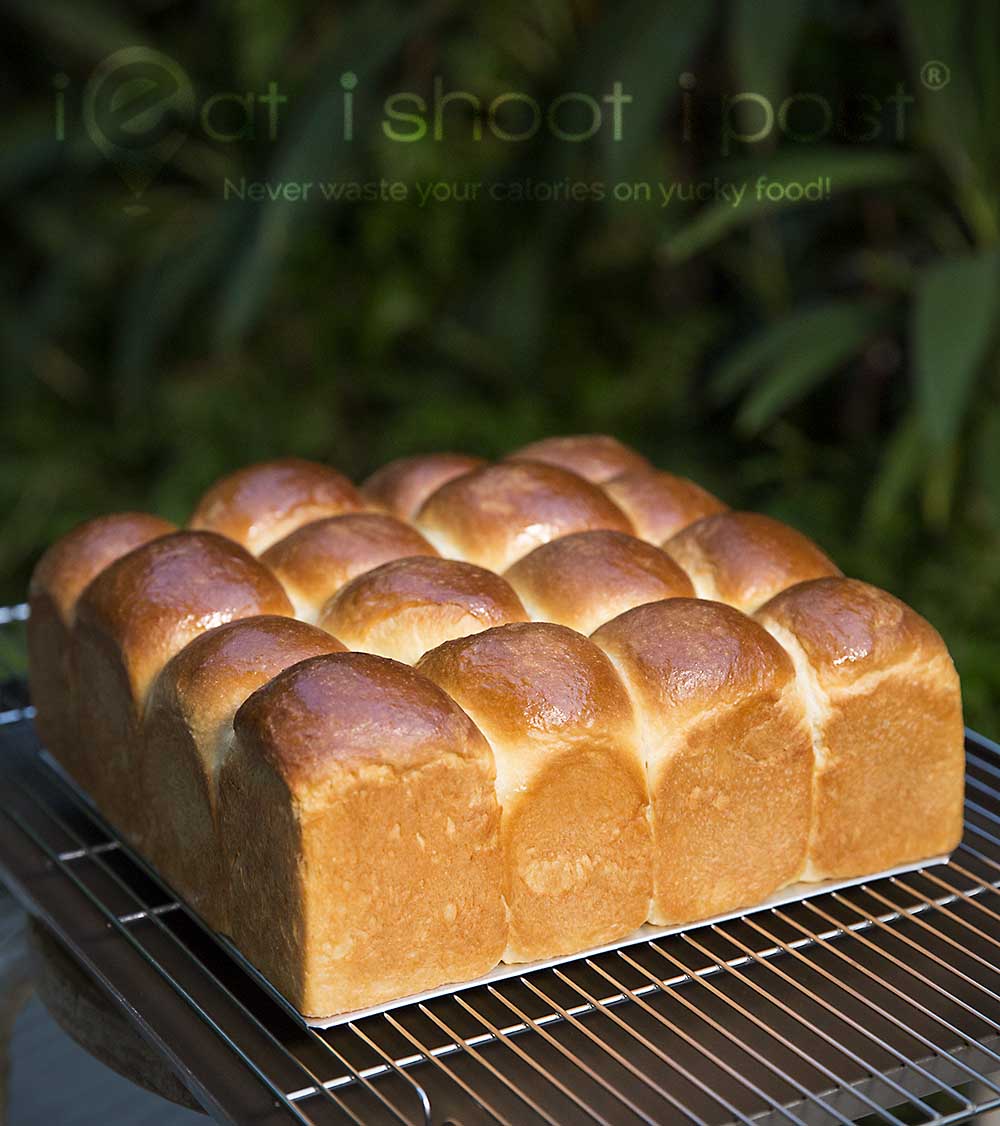
These traditional kopi tiam buns are the reason I bought Christopher Tan’s excellent recipe book, Nerdbaker. I flipped open the book and was immediately smitten by these soft and pillowy buns which are traditionally served with a slice of cold butter, kaya, soft boiled eggs and accompanied by a cup of kopi C. The classic Singaporean breakfast doesn’t get better than this!
Chris’s method is quite unique because he separates the yolks and whites and adds the yolks first to the warm potato slurry. I had to convince myself of the need for this extra step, so I baked another tray of potato bread from another recipe book and Chris’s method proved to be superior. The cooked potato slurry is similar to making a tangzhong (water roux) bread where a cooked starch is added to the dough to improve its texture and prolong its softness. These buns are super soft with a stretchy crumb, buttery aroma and crisp, toasty crust!
Chris’ recipe is made in a round tin which means that the buns are not evenly shaped. I wanted buns which are uniform, like the ones they serve at the kopitiam, so I modified the recipe to make 16 buns in a square baking pan. The method is essentially the same as in Nerdbaker.

Ingredients:
Wet Team
Russet potato 120g diced (1 medium sized)
Water 270ml
Castor sugar 90g
Milk powder 40g
Egg yolks 2 (60g eggs)
Egg whites 2
Dry Team
Bread flour 600g
Salt 1tsp
Instant yeast 1Tbsp
Other Team
Butter 70g (soften to room temperature)
Melted butter for glazing
23cm square aluminium pan
Method
1. Boil diced potatoes in 270ml water for 8 min till soft. Lower heat to a simmer and use a tight lid to prevent water loss.
2. While still warm, whisk potatoes till smooth, then add castor sugar, milk powder and egg yolks and whisk.
3. Allow to cool to room temperature and whisk in egg whites.
4. Mix flour, yeast and salt and add the wet team. Mix until just combined and allow to rest for 20 mins. Cover with wet towel.
5. Knead for 1 min in a stand mixer, then rest for 5 mins. Repeat for another 2 cycles.
6. Add butter and knead for another 2 mins. Rest for 5 mins and knead another 1-2 mins till well combined and smooth.
7. Cover with wet towel and leave to rise for 50 mins or until doubled in size.
8. Weigh the dough and divide into 16 portions (Approx 74-75g)
9. Ball the dough and leave to rest for 10mins.
10. Brush pan with melted butter
11. Shape the dough into tight balls and place in pan and allow to rise for 1 hour.
12. Brush with butter
13. Bake at 180°C (fan forced) for 27-30mins till top of bun is dark brown and the buns in the middle feel hollow when tapped.
14. Allow to cool before serving. ALLOW TO COOL! Do not succumb to the temptation of eating it right out of the oven even though it smells so wonderful! YOU HAVE BEEN WARNED!
Here are the step by step instructions with detailed explanation:

1. Boil diced potatoes in 270ml water for 8 min till soft. Lower heat to a simmer and use a tight lid to prevent water loss. If the potatoes are not soft enough to mash with a fork, then continue to cook a little longer.

2. While still warm, whisk potatoes till smooth, then add castor sugar, milk powder and egg yolks. The egg yolks will cook in the slurry and thicken it, essentially forming a custard.
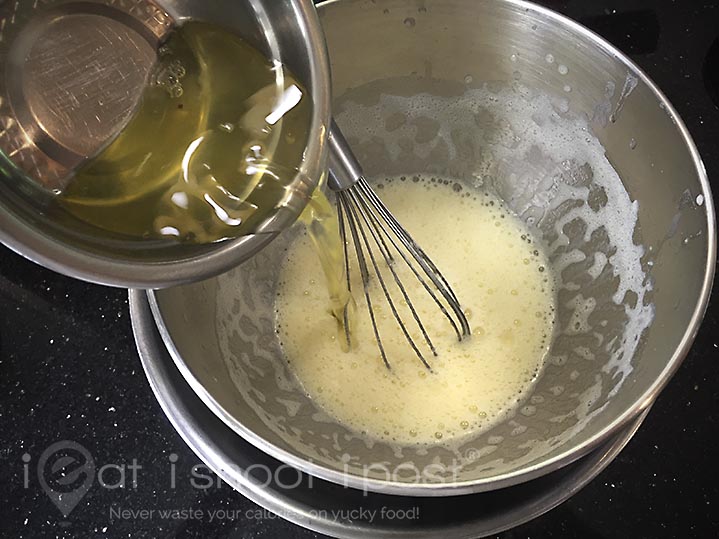
3. Allow to cool to room temperature and whisk in egg whites. Do not whisk in egg whites while the mixture is hot as the whites will stiffen.

4. Mix flour, yeast and salt and add the wet team. You can use the handle of a wooden spoon to do this or just mix with the kneading hook.
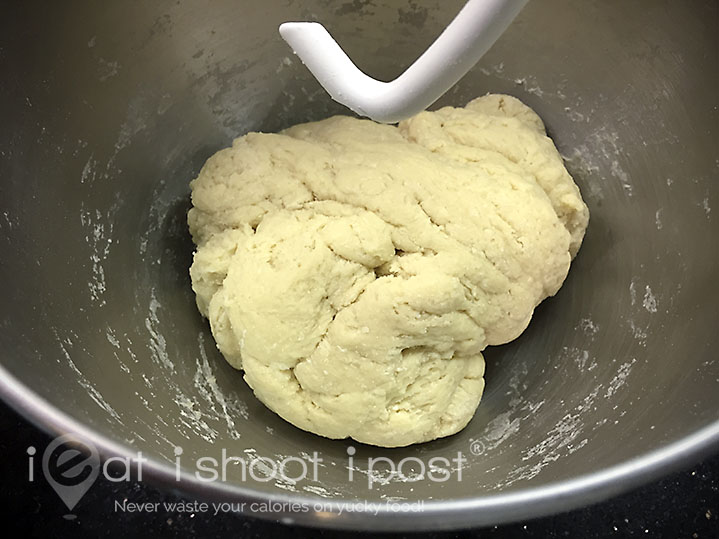
Mix until just combined and allow to rest for 20 mins. This process is known as “autolysis” and allows for better gluten formation with less kneading required. Cover with wet towel.
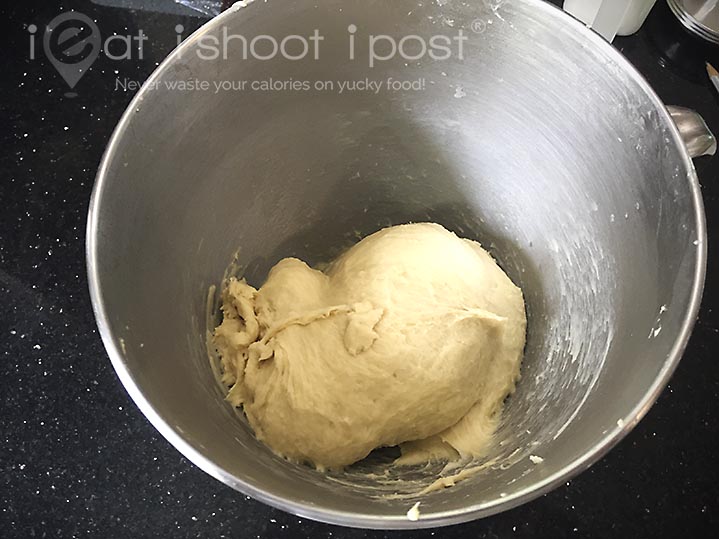
5. Knead for 1 min, then rest for 5 mins. Repeat for another 2 cycles. The resting in between allows the dough to rest and helps to develop the gluten.

When the dough is stretchy like this, it is time for the butter.
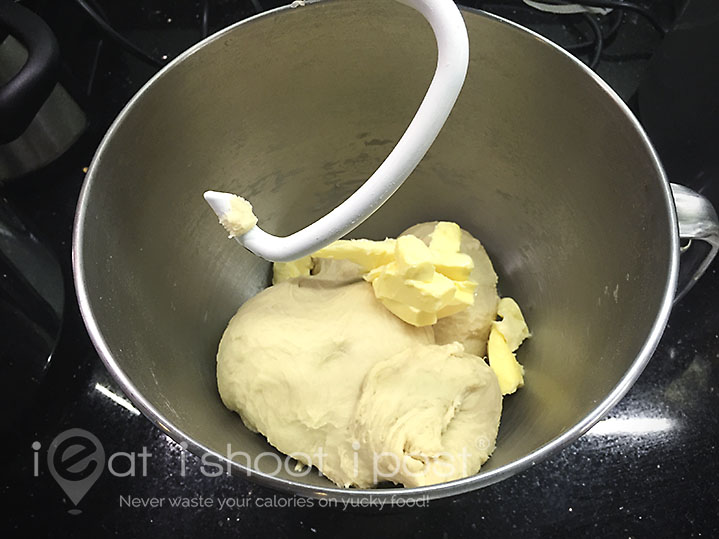
6. Add butter and knead for another 2 mins. Rest for 5 mins and knead another 1-2 mins till well combined and smooth. Butter is a shortening agent ie it prevents gluten from forming. That is why cookies is full of butter. When butter is added to low protein flour, it results in tender crumbly cookie crust. Adding the butter after the gluten as formed allows for a soft bready crumb which is still stretchy.
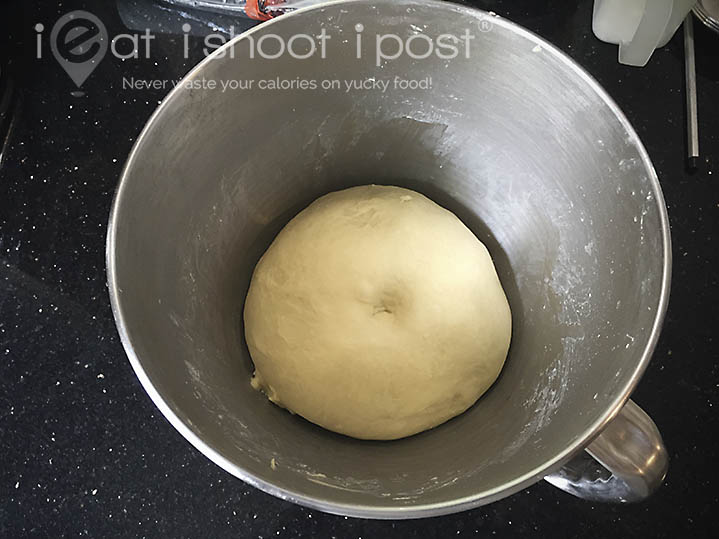
7. The dough is ready when it is smooth like this with just a dusting of flour on the surface and a bit of shaping. Cover with wet towel and leave to rise for 50min or until doubled in size.
8. Weigh the dough and divide into 16 portions (Approx 74-75g). I would usually weigh the dough and divide it into four equal portions and then further divide into four equal portions. Yes I do weigh each ball because if you don’t you will get buns of uneven height.
The above video shows the process of balling and shaping the dough.

9. Ball the dough and leave to rest for 10mins. The resting time allows the gluten to relax before the final shaping.

11. Shape the dough into tight balls and place in pan and allow to rise for 1 hour. It is essential in this step to make sure that the thin surface membrane doesn’t break. What you want to do is to keep stretching the outside of the ball so that it is nice and tight. Then you will get nice buns with smooth tops. Don’t be too stress if you can’t get them smooth the first time, the buns will still be delicious. It just wouldn’t be as brag worthy, that’s all.
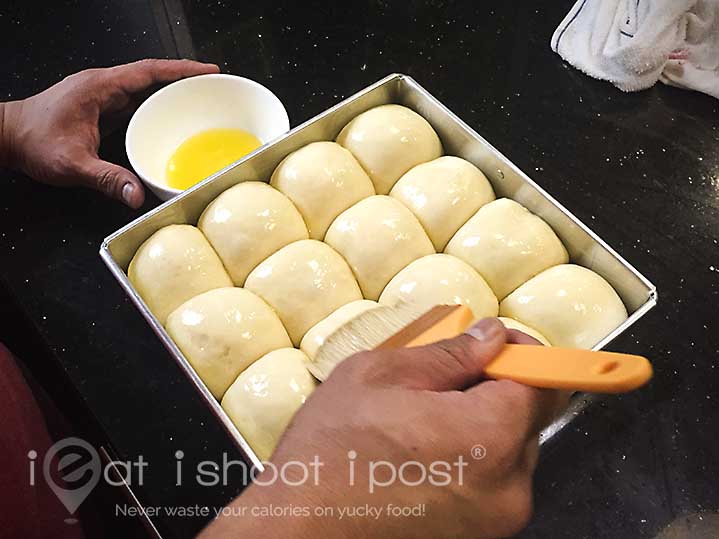
12. Brush with melted butter. Make sure you use a soft brush and be gentle. You don’t want to accidentally make ugly brush marks on the surface of the buns!
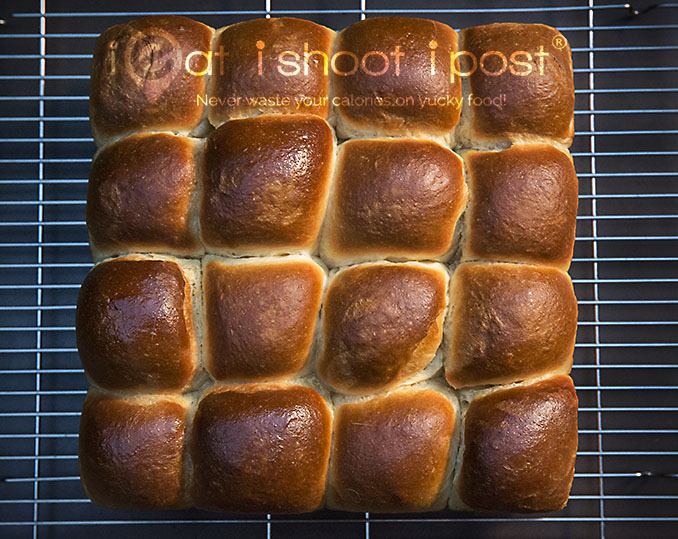
13. Bake at 180°C (fan forced) for 27-30mins till top of bun is dark brown and the buns in the middle feel hollow when tapped. If the buns start to brown too early, cover with aluminium foil to prevent it from becoming too dark.
Allow to cool and serve with good quality French Butter (seriously, you made so much effort, why serve it with anything less?) and homemade kaya!
Here is my video recipe for kaya.
Disclosure: Some links above are affiliate links, meaning, at no additional cost to you, we will earn a small commission if you click through and make a purchase.



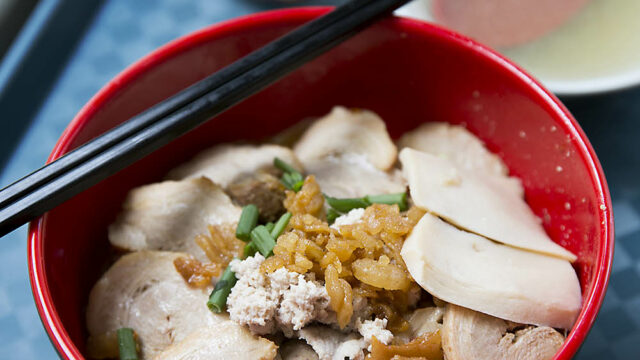
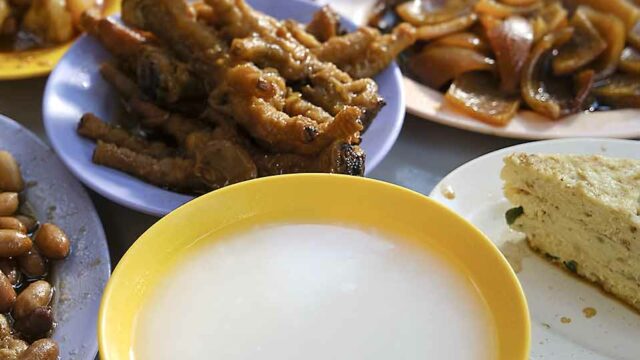



Chinese/Asian baking is interesting to me. The texture is so different to Western style bread. // I bet you could make some amazing bread pudding with this bread!!~
Hi, what kind of milk powder do u use? TIA
The book wasn’t easy to find in North America, but I managed to get a used copy. Looking forward to making these.
Simmer for 8 mins or until the potato is soft enough to mash.
Whisk both water and potato together.
In general, you should mix at low speed because the dough is tough.
Yes, you should always use unsalted butter in baking and add salt as per the recipe.
Try to buy skim milk powder from the bakery shop! Otherwise any milk powder is fine.
Hi, may I know which built in oven do you use? Can share? Thanks!
I am currently using a SMEG pizza oven.
Do you think I can replace the potatoes with sweet potatoes? Thanks!
I am not sure, but you can try!
Did you follow the recipe exactly? Which bit did you change?
I made this today and it is very soft although it looks weird. Thanks for sharing Dr Tay ?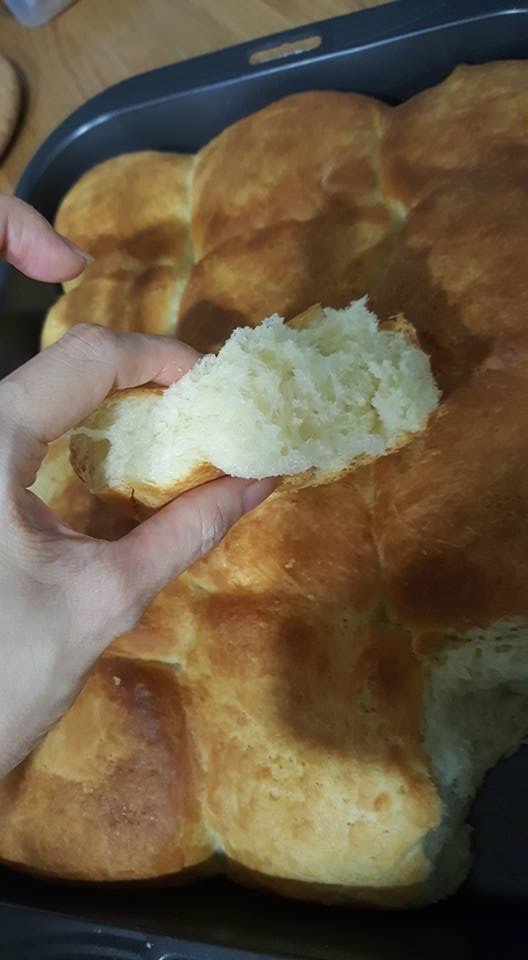
Was it nice to eat?
Yes..
Then you’ve done well! The shaping of the buns take a bit of practice. But nowadays, “ugly buns” are the in thing!
? Thanks for your encouragement. I will try and do a better job next time ?
Tried the recipe a few weeks ago. Turned out quite well for first time making bread. Thank you for the detailed instructions!
Well done! Thanks for letting me know!